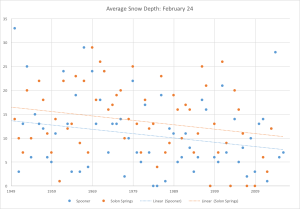The updates from the race today did not look good. First there was the all-too-green update from Fish Hatchery. Then came the selfie-style video from the Birkie staff office, which almost made this stoic skier cry. Before Ben opened his mouth I knew the news was not good. The trail is down to grass. It will be very hard to hold a race.
Had some base remained north of OO, things would be different. But the timing of the storm, from a race-organization perspective, is terrible. If the snow fell today, there’d be plenty of time to groom it, let it set up and freeze down, and have a compact base for 10,000 skiers, even with just grass underneath. If it fell on Sunday, it would be too little, too late. As it stands, it’s falling on Friday on to grass. Temperatures will be cold enough that it will freeze in to the soil as it falls, but there won’t be enough time to groom the snow and have it set up in to a solid base, probably unless there is a major shift in the forecast and more than a foot falls. As it stands, forecasts are still in the 3 to 15 inch range, so it could be anywhere from a nothingburger to a big storm.
What seems to be the case is that Ben and the Birkie staff are trying to tamp down expectations. They of course want to have a ski race, but there will be no way to know if there will be enough snow for that until, at the earliest, Friday morning. If they wake up to an all-out blizzard on Friday with temperatures in the low 20s and 10″ of new snow, the groomers might be able to go out and pack the course enough to have a firm enough skate deck for the race on Saturday. (But there’s the issue that for snow falling on warm ground, you don’t want to groom it right away, but you don’t have time to let it firm up instead, because the race is on Saturday.) But if it’s anything less, a few people snowplowing down bobblehead hill will scrape it down to grass for thousands behind, and the already-tricky hill could turn in to a real mess. And certainly not something suitable for a timed race.
Time will tell. But right now, time doesn’t look to be on our side.



